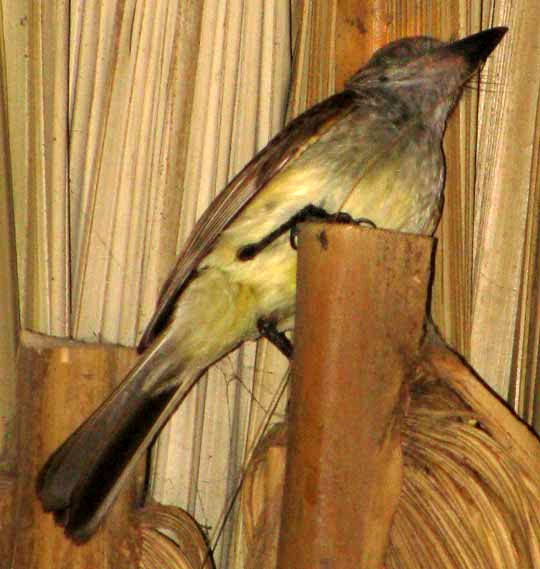Excerpts from Jim Conrad's
Naturalist Newsletter

from the February 28, 2010 Newsletter issued from Hacienda Chichen Resort beside Chichén Itzá Ruins, central Yucatán, MÉXICO; limestone bedrock, elevation ~39m (~128ft), ~N20.676°, ~W88.569°
A FLYCATCHER PUZZLE
Eastern US birders know the Great Crested Flycatcher. He's a robust bird with a low crest, rustiness flashing in his wings and tail, and calling with loud, sharp, ascending WHEEP, WHEEP, WHEEPs. The calls remind me of summer because they're so typically heard up north during the summer, especially at woods edges next to fields. In the East there's nothing similar to the Great Crested.
Great Cresteds overwinter here in the Yucatan, plus we have three other very similar, permanent-resident flycatcher species: the Yucatan; the Dusky-capped, and; the Brown-crested. All four look-alike species are members of the genus Myiarchus.
Therefore, I just didn't know which flycatcher I had the other day when one perched in a leafless Kikché tree 20 feet away. I got pictures of him, though, seen at the top of this page.
Of the four species, the Yucatan and Dusky-capped species hang together because of their smallish bills. You can compare the above bird's bill with the smaller bill of a Yucatan Flycatcher, probably, seen in 2008, at www.backyardnature.net/yucatan/becardgc.htm.
Our bird's bill is clearly larger than that one. So, this week's bird is either the Great Crested or the Brown-crested Flycatcher. Distinguishing those two species can be tricky. The Brown-crested is generally paler overall than the Great Crested, his belly isn't as yellow as the Great Crested's, the contrast between his yellow belly and grayish throat isn't as sharply defined, and the Brown-crested's lower mandible is predominantly black while the Great Crested's is extensively fleshy at its base. These traits are hard to see in poor light, though.
Once I could compare my pictures with field guide illustrations I came to this conclusion: Brown-crested Flycatcher, MYIARCHUS CRINITUS.
Brown-crested Flycatchers WHEEP, WHEEP, WHEEP similarly to Great Cresteds, even occasionally now, in the dry season. My impression is that here Brown-cresteds are the most common of Yucatán's four look- alike Myiarchus flycatchers.
Brown-cresteds, called Wied's Crested Flycatchers in older field guides, are distributed from southern Texas and the US desert Southwest south to Costa Rica, with a another population from Columbia to northern Argentina.
from the July 4, 2010 Newsletter issued from Hacienda Chichen Resort beside Chichén Itzá Ruins, central Yucatán, MÉXICO; limestone bedrock, elevation ~39m (~128ft), ~N20.676°, ~W88.569°
FLYCATCHERS IN THE HUT
Friday morning after the garden work I entered the hut to find two flycatchers flying around. One is shown below:

They were fledglings keeping silent as they flitted about, and no adults were trying to coax them outside with their calls. The fledglings' plumages hadn't acquired all the adults' colors but they showed enough for me to guess that they were Brown-crested Flycatchers, the common flycatcher species here. If someone wanted to argue for the very similar, endemic Yucatan Flycatcher, I wouldn't debate the issue. I haven't seen adult Yucatan Flycatchers here yet though.
The fledglings stayed the whole day, until a little before dusk, and I suspect that they got hungry. I could imagine the conflicting urges they felt as they perched on my roof beams watching me at the computer. On the one hand they knew that outside they could find insects to eat, yet also they must have been fearful of the world's terrors. That same morning, during breakfast, I'd seen a Yucatan Gray Squirrel carrying something bulky in its mouth hotly pursued by two Clay-colored Robins. I'll bet the squirrel had robbed a robin's nest. The day before a Black Vulture flew overhead and for a fraction of a second as the vulture shook his head to get a better grip on something in his beak I thought I saw the silhouette of wings struggling for purchase on the air.
If you're given to robbing birdnests of nestlings, this is the very moment of the year to do it, here at the beginning of the rainy season when trees and bushes host whole cities of caterpillars providing ready food for growing families.